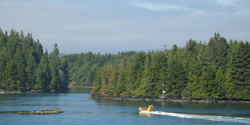
There are numerous operations offering whale watching and marine mammal tours, mostly from Vancouver Island but also in the Queen Charlotte Islands, Prince Rupert, Sunshine Coast and Vancouver.
The coast of BC is the fortunate home of several species of whales and other marine mammals, including porpoise, seals, sea lions, and sea otters.
Whales include Humpback and Grey, and for the first time in over 50 years, sighting have been made of the largest mammal on earth, the Blue Whale. These species move through the coastal waters as they migrate north in the summer, feeding on the plankton rich seas of the North Pacific. In the case of Grey and Humpback, the migration patterns are deeply set, and can be relied on as the Humpbacks move from Hawaii, where they calve to the North East Pacific where they fatten; and the Greys who move from Baja and then north for the same purposes.
Other whales include Sperm and transient Orcas (Killer Whales). Both are opportunistic hunters and feed on other marine life. Orcas will eat seals, seal lions, walrus and other whales, but do not eat fish. Sperm whales, rarely seen, are specialists in deep diving, reaching depths of 2200 metres and will eat fish, but they specialize in Giant Squid.
The most famous whales on the coast are the Resident Orca pods, one of the subspecies of Orcas. They feed on salmon and take up positions, many in the Georgia Basin and North Eastern Vancouver Island, for months at a time. They are the whales most seen by whale watching boats because of their regularity and tendency to stay in specific areas. They are also perhaps the most vulnerable because of their specialized diet relying solely on the health of salmon stocks, as subjects of human interaction, and as top predators that can concentrate pollutants in populated coastal areas.
Total listings: 0 Showing:
Page:
advertise on GoBC

